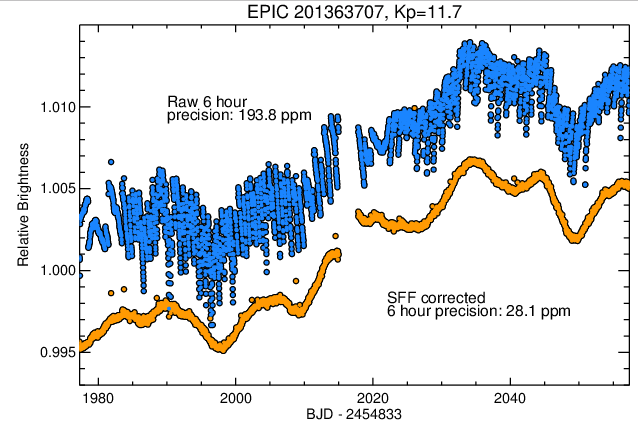Mission Overview
K2 Extracted Lightcurves (K2SFF)
Primary Investigator: Andrew Vanderburg
HLSP Authors: Andrew Vanderburg
Released: 2015-03-13
Updated: 2020-10-08
Primary Reference(s): Vanderburg & Johnson (2014)
DOI: 10.17909/T9BC75
Citations: See ADS Statistics

Overview
The lightcurves from K2 contain larger systematics than the original Kepler mission, due to the reduction in pointing precision as a result of having to rely on only two reaction wheels. Vanderburg & Johnson have created a technique to correct for the pointing-dependent nature of the pixel-level fluxes. This correction improves the photometric precision by typical factors of 2-5, and results in median photometric performance of K2 targets to within a factor of two of the original, 4-wheeled mission.
The team have released their extracted lightcurves (using a variety of photometric apertures), as well as diagnostic plots, for each target. Simplified, ASCII text tables of the corrected lightcurves, excluding observations during thruster firings, are provided for the aperture that results in the lowest rms. Most users will prefer to download the FITS lightcurves, which include all data points (with flags to indicate thruster firing), as well as multiple versions (each FITS extension is an extracted lightcurve for a different aperture). There are a total of twenty apertures provided: ten circular and ten based on the pixel response function. The final extension contains the summed image from all the postage stamp frames.
The most recent release consists of 2,357 light curves of sources extracted from the M67 superstamps in Campaign 16 and Campaign 18.
Data Products
Each target is organized into a subdirectory structure, based on its EPIC ID, with the following format:
c<##>/<####00000>/<#####>/
where:
- c<##> is normally the 2-digit, zero-padded Campaign number the target was observed in. There are some exceptions: the engineering campaign uses "cet" for this field. Some campaigns, like Campaign 10, were split into two sub-campaigns designated as "c101" and "c102". There are K2SFF light curves for c102 only, and in this case the campaign number is a 3-digit field. Others have light curves for both, e.g., "c111" and "c112" for Campaign 11.
- <####00000> are the first FOUR digits of the target's EPIC ID
- <#####> are the last FIVE digits of the target's EPIC ID
For example, the star EPIC 202059070 was observed in Campaign 0. It's subdirectory path is therefore:
<...>/c00/202000000/59070/
Several files are available for each target. Each file has the same prefix ("hlsp_k2sff_k2_lightcurve_{EPICID}-c##_kepler_v1"), followed by an extension. The extensions and types for these files are:
| _allfiles.tar.gz | A tarball containing all files for this target. |
| _correction.png | A plot showing the corrected flux as a function of arclength distance across the detector. |
| _image.png | A plot showing the summed image from all postage stamp frames. |
| _llc-default-aper.txt | ASCII text table containing time and corrected flux values for the default ("best") aperture. |
| _llc.fits | FITS file containing extracted lightcurves for all aperture sizes/shapes. The first extension contains a binary FITS table with the time, corrected flux, raw flux, arclength distance, a flag indicating whether a thruster firing was occurring, and the cadence number for all observations, using the "best" aperture size/shape. The next twenty extensions contain similar tables for every aperture size/shape. The 22nd and 23rd extensions contain tables that define each circular and PSF aperture, respectively. The final extension contains the summed image of all the postage stamp frames. |
| _llc.png | A plot of the raw and corrected fluxes for the "best" aperture. |
| _medians.png | A plot of the median background count per pixel as a function of time for the "best" aperture. |
| _skypos.png | A plot showing the location of the target in the K2 field-of-view. |
Data Access
K2SFF light curves are available in the MAST Portal (web-based, cross-mission search interface) and Astroquery (Python package to search for and download files from Python scripts you write), and a MAST Classic Search Form (web-based form with mission-specific metadata available). For those who want to download all K2SFF light curves for a given Campaign, we provide bulk download scripts in the table below.
-
A web-based interface for cross-mission searches of data at MAST or the Virtual Observatory. Download K2SFF light curves for a few targets.
-
Search for, and retrieve, K2SFF data products programmatically based on a list of coordinates or target names.
-
A web-based form to search based on target, coordinate, or metadata. Specify output format: HTML table, CSV files, or download scripts.
Note: The Campaign 5 data include 1,504 targets extracted from the M67 super-stamps. These stamps consist of 72 individual apertures, aligned to create a contiguous 400x400 pixel region. You can locate these 72 stamps by setting "Object Type" to "M 67" in the MAST K2 Search Form. The 1,504 targets, which use smaller apertures within these stamps, all have EPIC IDs, although there are not mission-produced light curves for these objects.
| cURL Script Files By Campaign (Downloads FITS Files Only) | |||||
|---|---|---|---|---|---|
| Campaign ENG | Campaign 0 | Campaign 1 | Campaign 2 | Campaign 3 | Campaign 4 |
| Campaign 5 | Campaign 6 | Campaign 7 | Campaign 8 | Campaign 9 | Campaign 10 |
| Campaign 11 | Campaign 12 | Campaign 13 | Campaign 14 | Campaign 15 | Campaign 16 |
| Campaign 17 | Campaign 18 | Campaign 19 | |||



